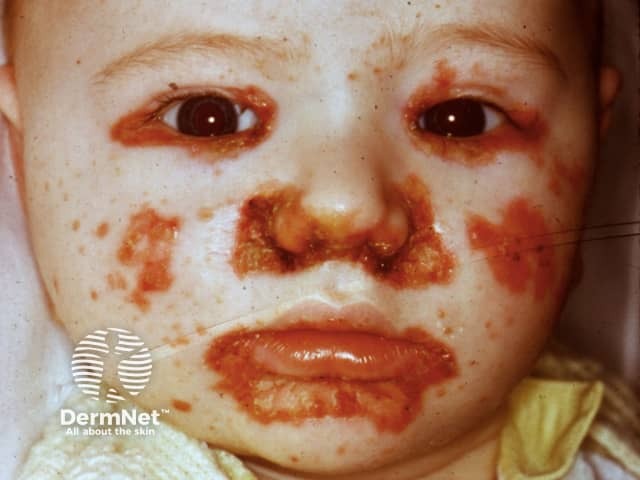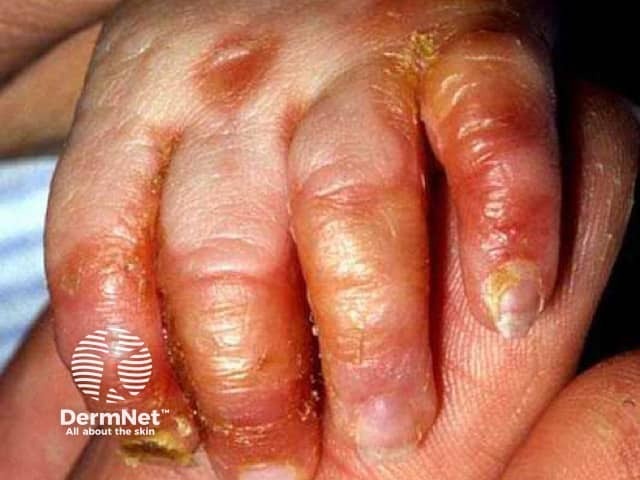Main menu
Common skin conditions

NEWS
Join DermNet PRO
Read more
Quick links
Acrodermatitis enteropathica-like conditions — extra information
Acrodermatitis enteropathica-like conditions
Author: Leah Jones, Medical Registrar, Christchurch, New Zealand. DermNet Editor in Chief: Adjunct A/Prof Amanda Oakley, Dermatologist, Hamilton, New Zealand. Copy edited by Gus Mitchell. May 2020.
Introduction - Acrodermatitis enteropathica Introduction Demographics Causes Clinical features Complications Diagnosis Differential diagnoses Treatment Outcome
What is acrodermatitis enteropathica?
Acrodermatitis enteropathica is a rare genetic disorder of zinc metabolism characterised by the triad of dermatitis, diarrhoea, and alopecia [1]. It is an autosomal recessive condition caused by a mutation in the SLC39A4 gene, which codes for a zinc transporter protein [1,2].

Acrodermatitis enteropathica

Acrodermatitis enteropathica

Acrodermatitis enteropathica
What is an acrodermatitis enteropathica-like condition?
An acrodermatitis enteropathica-like condition presents with similar features to acrodermatitis enteropathica, but is caused by acquired zinc deficiency or a disorder of amino acid or fatty acid metabolism [1].
Acrodermatitis enteropathica-like conditions include:
- Acrodermatitis metabolica when secondary to a metabolic disorder
- Acrodermatitis acidemica when secondary to an organic acidaemia [1].
Who gets an acrodermatitis enteropathica-like condition?
An acrodermatitis enteropathica-like condition can be categorised as secondary to acquired zinc deficiency or to a metabolic disorder unrelated to zinc deficiency [1].
Acquired zinc deficiency
Causes of acquired zinc deficiency include [1-4]:
- Inadequate zinc intake (due to low breast milk levels, anorexia nervosa, total parenteral nutrition, or inadequate diet)
- Intestinal malabsorption (coeliac disease, Crohn disease, ulcerative colitis, cystic fibrosis, pancreatic dysfunction, high copper/iron/phytate intake, short bowel syndrome, medications)
- Increased urinary zinc excretion (nephrotic syndrome, liver cirrhosis, infection, diabetes mellitus, excessive alcohol ingestion, diuretics)
- Increased digestive fluid loss (intestinal fistula, diarrhoea)
- Increased requirements (pregnancy, lactating mothers, preterm infants)
- Low albumin and high metabolic demands (thermal burn, excessive sweating, liver cirrhosis, haemolysis).
Metabolic disorders
An acrodermatitis enteropathica-like condition related to a metabolic disorder can be secondary to:
- A congenital condition present in the newborn period
- An acquired deficiency of protein or biotin deficiency, which can present at various stages of life [1,3].
Acrodermatitis enteropathica-like conditions secondary to metabolic disorders are caused by abnormalities disrupting the metabolism of amino acids or fatty acids [1]. This can be direct, through disruption of the urea cycle, or by affecting co-factors, notably biotin [1–3].
Metabolic disorders responsible for acrodermatitis enteropathica-like conditions include [1–3]:
- Organic acidaemias, including:
- Propionic acidaemia
- Methylmalonic acidaemia
- Glutaric aciduria type 1
- Multiple carboxylase deficiency
- Maple syrup urine disease
- Phenylketonuria
- Ornithine transcarbamylase deficiency
- Citrullinaemia
- Carbamoyl phosphate synthetase deficiency
- Kwashiorkor [see Protein-energy malnutrition]
- Acquired biotin deficiency due to a restrictive diet (rare).
Necrolytic migratory erythema can present with a rash similar to acrodermatitis enteropathica in adults and is associated with glucagonoma [1].
What causes an acrodermatitis enteropathica-like condition?
When an acrodermatitis enteropathica-like condition is related to acquired zinc deficiency, the lack of zinc leads to abnormal keratinisation, cell proliferation, and defective immune response [1].
In metabolic disorders, amino acid or fatty acid deficiency leads to reduced keratinocyte growth and differentiation [1].
What are the clinical features of an acrodermatitis enteropathica-like condition?
Like its namesake, an acrodermatitis enteropathica-like condition typically presents with the triad of dermatitis, diarrhoea, and alopecia [2].
Cutaneous features
The cutaneous features of an acrodermatitis enteropathica-like condition include [1–3]:
- Acral and periorificial distribution
- Well-demarcated, symmetrical, erythematous, eczematous, or psoriasiform plaques and vesiculobullous lesions
- Angular cheilitis
- Poor wound healing.
Other features
Other features of an acrodermatitis enteropathica-like condition depend on the underlying cause, but often include [1,3,5]:
- Failure to thrive
- Neurological defects, such as developmental delay, seizures, and hypotonia
- Ophthalmic abnormalities, such as cataracts and retinitis pigmentosa
- Metabolic abnormalities, such as acidosis, ketosis, and hyperammonaemia.
What are the complications of an acrodermatitis enteropathica-like condition?
An acrodermatitis enteropathica-like condition can be complicated by secondary bacterial infection or candidiasis [1].
Decompensation of a congenital metabolic disorder during periods of illness or stress may result in acidosis, which is potentially fatal [5]. Long-term neurodevelopmental problems are not uncommon in congenital metabolic disorders [1,5,6].
How is an acrodermatitis enteropathica-like condition diagnosed?
Acquired zinc deficiency is associated with low serum zinc levels and alkaline phosphatase [2]. Zinc levels and alkaline phosphatase tend to be normal in acrodermatitis enteropathica-like conditions related to metabolic disorders [1].
A full blood count may reveal cytopenias in both acquired zinc deficiency and metabolic disorders [2,5].
The initial blood tests for an organic acidaemia may include [5]:
- pH
- The partial pressure of carbon dioxide
- Bicarbonate
- Lactate
- Electrolytes
- Urea
- Creatinine
- Glucose
- Pyruvate
- Ammonia.
Levels of specific amino acids or enzyme activity and the presence of organic acids in the urine may support a specific diagnosis [1,5].
Newborn screening detects many of the congenital metabolic causes of acrodermatitis enteropathica-like conditions and is available in many parts of the world including New Zealand, Australia, the United Kingdom, the United States, and Canada [5].
A skin biopsy of an acrodermatitis enteropathica-like condition has non-specific histopathology; epidermal pallor and confluent parakeratosis may be observed [7].
What is the differential diagnosis for an acrodermatitis enteropathica-like condition?
The differential diagnosis of an acrodermatitis enteropathica-like condition includes:
- Acrodermatitis enteropathica — genetic analysis of the SLC39A4 gene distinguishes this [2]
- Atopic dermatitis — this uncommonly affects the napkin area and lacks systemic symptoms
- Psoriasis — psoriasis causes erythematous scaly plaques and does not cause vesiculobullous and eczematous lesions [1,3]
- Napkin dermatitis — this is confined to the napkin area and has no systemic features.
What is the treatment for an acrodermatitis enteropathica-like condition?
An acrodermatitis enteropathica-like condition secondary to acquired zinc deficiency will resolve after oral zinc supplementation, usually at an initial dose of 0.5–1 mg/kg/day of elemental zinc [2]. Whether there is an ongoing need for zinc replacement will depend on the cause [2,8].
An acrodermatitis enteropathica-like condition secondary to a metabolic disorder generally responds to dietary manipulation and medication in the form of specific organic supplements to correct metabolic deficiencies [5]. Expert assistance should be sought from a nutritionist.
What is the outcome for an acrodermatitis enteropathica-like condition?
The outcome for an acrodermatitis enteropathica-like condition depends on the underlying condition.
Acquired zinc deficiency
An acrodermatitis enteropathica-like condition secondary to acquired zinc deficiency has a favourable prognosis if identified early [8,9]. The dermatological, gastrointestinal, and psychological manifestations tend to resolve within days to weeks following zinc replacement [9].
Metabolic disorders
An acrodermatitis enteropathica-like condition secondary to a metabolic disorder can have a high mortality rate in the newborn period if undiagnosed. This is mitigated to some extent by detection in the newborn period with the help of screening programmes [5]. A significant number of children diagnosed early with congenital metabolic disorders will still have ongoing problems with metabolic crises and neurocognitive development [5,6].
References
- Tabanlioğlu D, Ersoy-Evans S, Karaduman A. Acrodermatitis enteropathica-like eruption in metabolic disorders: acrodermatitis dysmetabolica is proposed as a better term. Pediatr Dermatol. 2009;26(2):150–4. doi:10.1111/j.1525-1470.2008.00803.x. PubMed
- Gehrig KA, Dinulos JG. Acrodermatitis due to nutritional deficiency. Curr Opin Pediatr. 2010;22(1):107–112. doi:10.1097/MOP.0b013e328335107f. PubMed
- Crone J, Huber WD, Eichler I, Granditsch G. Acrodermatitis enteropathica-like eruption as the presenting sign of cystic fibrosis--case report and review of the literature. Eur J Pediatr. 2002;161(9):475–8. doi:10.1007/s00431-002-0982-0. PubMed
- Corbo MD, Lam J. Zinc deficiency and its management in the pediatric population: a literature review and proposed etiologic classification. J Am Acad Dermatol. 2013;69(4):616-24.e1. doi:10.1016/j.jaad.2013.04.028. PubMed
- Bodamer O. Organic academias: an overview and specific defects. UpToDate, 2020. Available here [accessed 4 Apr 2020]
- Grünert SC, Müllerleile S, de Silva L, et al. Propionic acidemia: neonatal versus selective metabolic screening. J Inherit Metab Dis. 2012;35(1):41–9. doi:10.1007/s10545-011-9419-0. PubMed
- Lie E, Sung S, Yang SH. Adult autoimmune enteropathy presenting initially with acquired acrodermatitis enteropathica: a case report. BMC Dermatol. 2017;17(1):7. doi:10.1186/s12895-017-0059-4. PubMed
- Abrams SA. Zinc deficiency and supplementation in children. UpToDate 2020 [cited 2020 Apr 14]. Available here [accessed 14 Apr 2020]
- Krebs NF. Update on zinc deficiency and excess in clinical pediatric practice. Ann Nutr Metab. 2013;62 Suppl 1:19–29. doi:10.1159/000348261. PubMed
On DermNet
Other websites
- Acrodermatitis enteropathica — Medscape
